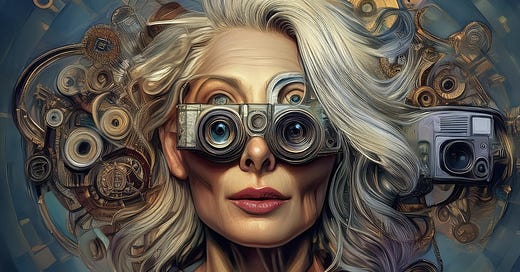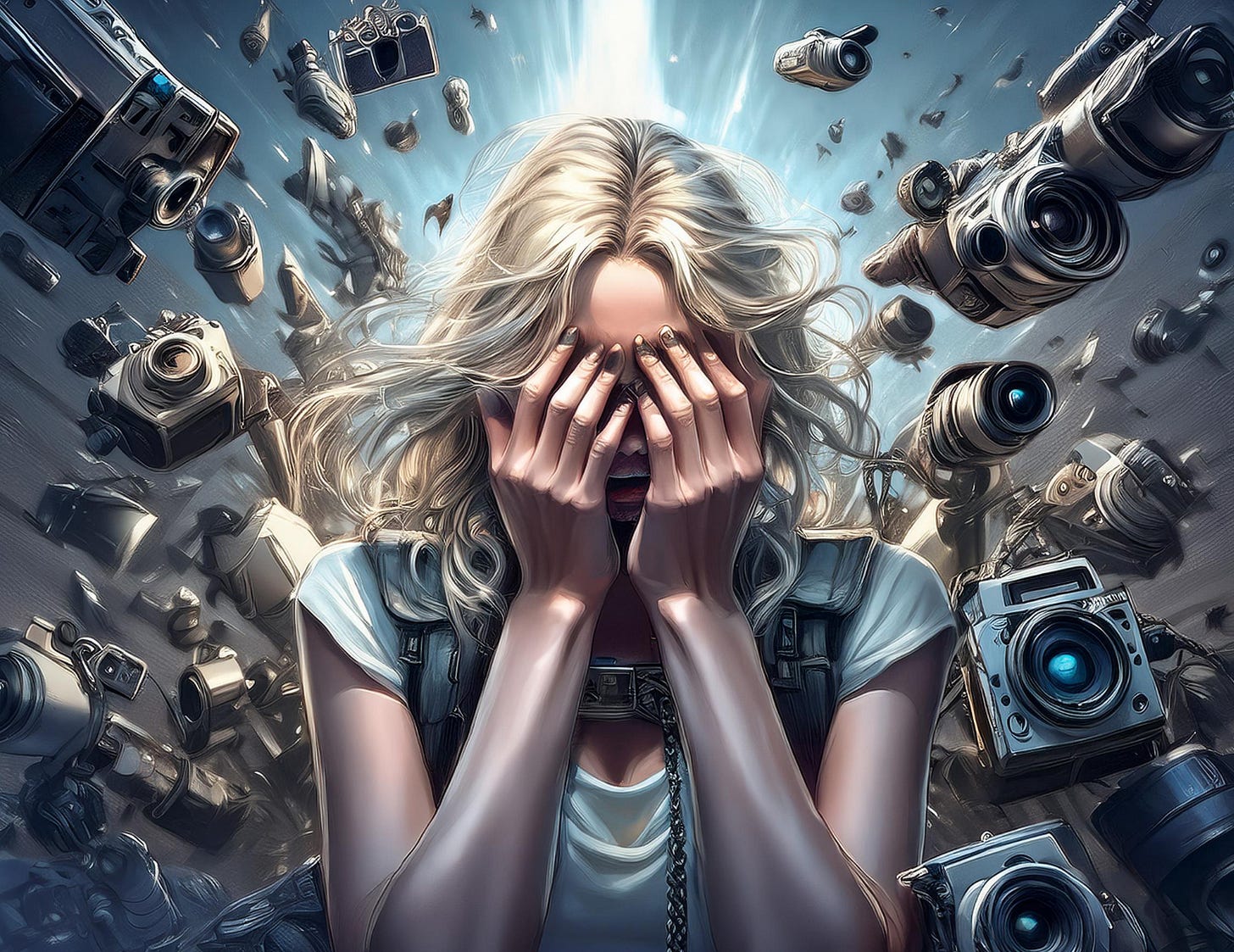Hello dear followers! You may have notice some changes. I changed the name of my publication and my last name. Yes, I did come out of the closet as a sex worker two years ago when I changed my Substack and my socials to my real name which was connected to my decades long vanilla career as a wedding photographer. This year I had my big wake up— I needed to get back to the career I abandoned a decade ago and I give most of my time and effort into setting up to make a comeback in a very competitive market. When I came out in 2022, I didn’t think I would ever go back to my ‘vanilla’ career where my clients and colleagues (who refer me clients) are my essentially my employers. When I Googled my name I had panic attacks seeing so many links about sex work, sex worker politics, my face and name on podcast about coming out as a sex worker (all on page one!) I reached to my sex educator colleague who interviewed me on the podcast and asked her to take it down (it’s a great podcast and I encourage you to listen to her other episodes.) I’m entering a market so saturated and competitive (probably worse than when I left) so why would I tie 50 pound weight to my neck trying to scale this mountain all over again? If my photography career was going strong and I had a best selling book that was picked up by a major publisher (with a big advance and movie rights) about my life going into sex work at age 42 and coming back to my high-end wedding career I started when I was 28, I would confidently publicize my name and plug it on my socials. My Substack is just a little journal to practice writing and it’s an intimate form of therapy, it’s currently not making me big income or advancing my career as a photographer. But I do appreciate my paying subscribers! Your subscription contributions this year paid for my new color correction monitor that I’ll be using for the thousand of wedding photos I’ll be editing in 2025 when I make my big comeback and take the wedding industry by storm (I’m laughing as I write this but try to not laugh at me, I’m manifesting what I want by writing it out.)
If you’re new to my Substack, this is the place to start. Hello, my name is M___ ___ and I’m a wedding photographer, a storyteller who speaks in images and words and I’ve also done hundred other paid and unpaid gigs in between. In other words, I’ve been a creative freelance hustler, artist, self-employed go-getter for most of my working life. This is an essay about the photography career once upon a time I started 25 years ago, the decade in the middle when I stumbled upon a secret underground world and found alternative work and a new community; and my trip back to Melissa 3.0, the experienced wedding photographer and newbie writer who started her comeback tour in 2024. I’ve done my best to edit and condense (I’m writing my memoir based on this essay.)
Digital Killed the Wedding Rock Star (or maybe it was just me?
I started really focusing on wedding photography full-time in my late 20’s and within a few years in I was in high demand. I got my own gallery storefront in Cambridge, Massachusetts where I met with couples getting married, but I was starting to feel burnt out from shooting so many events. By that time I had a pretty significant showcase portfolio so I simply started doubling my price every few months to slow down the flood. It surprised to me that I actually attracted more people, but a different type of client started to emerge—wedding planners referring me big budget brides with who wanted rehearsal dinner, welcome party coverage, pre-wedding engagement portrait sessions, bespoke custom designed photo albums and parents’ albums. I became a luxury wedding photographer before there was name for it. Looking back at this time in my life, I feel so grateful to have the good fortune starting my business in the pre-digital film days, to be one of handful of successful female wedding photographers in a very male dominated market (at the time) and shooting in a “candid photojournalistic” style, which was modern and new. It made wedding photography suddenly cool and it hadn’t become a trendy thing yet. I cornered the market as my work really stood out from the others.
Before I stopped shooting film and went all digital in 2003, I had spent around $15,000 a year on the film, developing and proof prints (each 36-exposure roll of film I shot was about $40 for the finished product.) I remember saying to my accountant at the time, “Now that I’m not paying for film and lab fees, I’m going to save so much money! Plus that now I don’t have scan any negatives to make digital prints, this will save me so much time!” Digital cameras had their issues in the beginning (skin tones had a weird magenta hue, they didn’t make them with full chip sensors so you couldn’t get the nice soft focus depth that a film camera had), but digital cameras started to improve quickly. They got cheaper and more popular as the average Joe could take a decent picture without needing to know about exposure, metering or F-stops. The back of the camera also had an LCD screen so you could what the image would look like in real time (no more carrying an external light around your neck to test flash exposures or using a Polaroid camera for image tests. You could take unlimited pictures which didn't cost a dime more than film. Freedom!
And now that I didn’t have a lab that was making proof prints from film, it was I who became the lab, doing hours of unpaid post production chained to my computer after every shoot.
And then cameras got even better and cheaper.
And then came along a few mediocre photographers turned motivational speaker salesfolk who saw the rising tides and they knew how to ride it out at the perfect time— they created software for wedding photographers to do custom slideshows and online proofing for client galleries. Everyone I knew used their product including me. They sold the company for a million as the software went obsolete and our clients could no longer access their images.*
And then cameras got even cheaper and more people wanted to try turning photography from a hobby to a profession.
And then the 2008 financial crisis happened. (queue sad trombone sound)
And that’s when I looked back and really missed paying that $15,000 a year for film and processing. I was eating those words I said to my account years earlier, I felt like I cursed myself. My wedding year peaked in 2010 (couples booked me 1-2 years in advanced) and each year after I had half the weddings from the previous year. And my rates went down and I offered services for free but it was never enough to compete with the flood of newly unemployed office managers who bought a Canon Rebel camera/flash package for $600 and were hungry. By that time, those office managers/photographers didn’t need to spend $1200 on an ad in a wedding magazine or even have a website. They could sell their $175 wedding photography package on a new free site on the internet called Craigslist.
I’ve critically analyzed so many times what I could have done differently to save the business or how I didn’t pivot at the right time and fucked it all up (like Kodak not recognizing the rise of smart phones taking over the point-and-shoot market, or Intel, the computer chip company who thought AI would be a passing fad and they lost all market share.)
Was it sticking with my self-hosted Blogger and Facebook instead of pivoting to Instagram? Not creating marketing content, selling courses, software and pre-set filters like every photographer/influencer on the planet? Should I have just stayed in Boston (where I knew lots of vendors) and not moved to the Bay Area to run with the rockstars of the Napa Valley destination wedding scene (and who snubbed me for years and to this day?) Was it the Miami wedding planner who gave me so many high-end events and weddings who retired by 2011?
By 2013, I also threw in the towel. I quit going to networking events, smiling and shaking hands telling everyone how busy I was, handing out business cards, following up and getting ghosted. Paying for expensive ads and wedding showcases that got me zero paid clients (but boy did I work for free and get that “exposure” like I was a college intern all again.) When my wedding career disappeared, my identity went along with it and I was lost. I stayed busy taking classes in documentary filmmaking (fun and creative but a very expensive hobby with no income.) I got my California real estate license— huge potential income, but it’s just like the wedding photographer scene but with all things I disliked: super competitive, oversaturated and 90% of the work is marketing yourself. I was done with being a hungry salesman passing out business cards and smiling through tears of rejection.
I started shooting boudoir images of my sex worker friends (fun but no real income and not nearly as challenging and creative as documenting a wedding day.) Then I started taking personal development workshops and peeled away layers of shame I had around sex, loving myself and who I being was in intimate relationships. It had a profound impact— I could envision a sex-positive business healing others, being sexy, having fun and I could monetize it. I took classes in tantra and BDSM. I enrolled in a program for somatic sex education and became a sexological bodyworker. I advertised under different names and personas doing many forms of sex work to pay the bills. I also became a decriminalization activist and speaker.
For the first few years I enjoyed the work and I actually made a lot money (I did so well that I bought a house, spent much of my time remodeling it and built a tiny house that I ended up renting out on Airbnb)*— but I never stopped missing taking pictures, creating love stories and making a really good living at what I genuinely loved doing. One of the other pluses of working in the “secret underworld” was getting away from Melissa 1.0, the failure. I got to invent a confident, hot and successful woman with a new name and persona, embody and market her. No one in the underworld has to know your real name, your “vanilla” job, your personal life or your past. The money ebbed and flowed but at one point I was making more than what I grossed at the highest point of my wedding photography career. It was very bittersweet.
I believed the only way to create wealth is do endure work you hate or simply tolerate and do the thing you really love on the side as a hobby. I’m still trying to change my mindset.
I felt stuck like I was working for someone else. I lost my freedom, creativity and I was tired of keeping Melissa the Photographer and all the work I was so proud of locked away in a closet.





